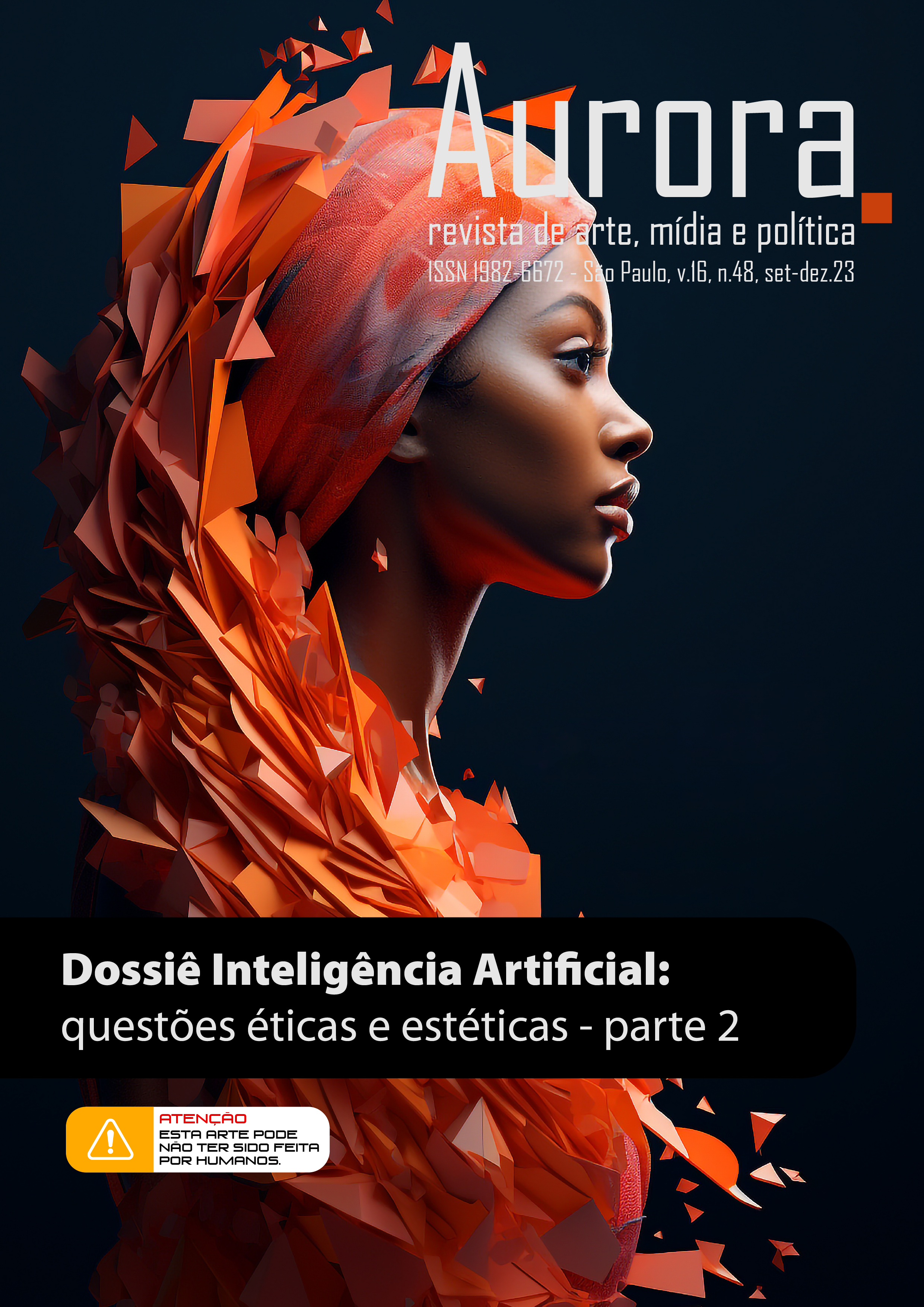Artist lies with Artificial Inteligence
mitômato and others creations
DOI:
https://doi.org/10.23925/1982-6672.2023v16i48p21-40Keywords:
artificial inteligence, deepfake, art and technology, digital artAbstract
"Artist Lie" (NUNES, 2016) refers to a universe of artworks that employ strategies aimed at deceiving the audience, using various medias, with a particular emphasis on those created with digital media. In line with discussions about the credibility of artificial intelligence systems, which have been involved in episodes of disinformation, artist lies created using these systems have emerged. In this sense, we have Spectre by Bill Posters and Daniel Howe, In event of Moon Disaster by Francesca Panetta and Halsey Burgund, Procura-se Helene Alberti by Larissa Campello and Discovering Digital Pioneers by Gustavo Romano. Additionally, we present the creation of the artwork Mitômato (2023), an experiment that brings together false "artist biographies" indicated as true by the well-known chatbot ChatGPT. These works stimulate critical reflections, exposing the fragile reliability of artificial intelligence systems.
References
ALMENARA, Igor. Como o Como o ChatGPT mentiu para convencer um humano a trabalhar para ele. Canal Tech. [S.l.]: Canal Tech, 2023. Disponível em: <https://canaltech.com.br/inteligencia-artificial/como-o-chatgpt-mentiu-para-convencer-um-humano-a-trabalhar-para-ele-245170/> . Acesso em: 30 mai. 2023.
BARBOSA, Tales Schmidke. Inteligência artificial e discriminação algorítmica. JOTA. [S.l.]: Jota, 2021. Disponível em: <https://www.jota.info/coberturas-especiais/inova-e-acao/inteligencia-artificial-e-discriminacao-algoritmica-10012021> . Acesso em: 10 mai. 2023.
BAUDRILLARD, Jean. Simulacros e simulação. Lisboa: Relógio D’água, 1991.
BEIGUELMAN, Giselle. A verdade dos deepfakes. Revista Zum. [S.l.]: Instituto Moreira Salles, 2020. Disponível em: <https://www.academia.edu/44881241/As_verdades_dos_deepfakes> . Acesso em: 08 jun. 2023.
BEIGUELMAN, Giselle. Inteligência artificial e a nova política de imagens. Revista Zum. [S.l.]: Instituto Moreira Salles, 2023. Disponível em: <https://revistazum.com.br/colunistas/inteligencia-artificial-e-as-novas-politicas-das-imagens/> . Acesso em: 08 jun. 2023.
CAIS [Center for AI Safety]. 8 Examples of IA Risk. [S.l.]: CAIS, [s.d.]. Disponível em: <https://www.safe.ai/ai-risk#Misinformation>. Acesso em: 08 jun. 2023.
CANEVACCI, Massimo; SUSCA, Vincenzo; ATTIMONELLI, Claudia. F for Real [registro em vídeo do Encontro F for Real, realizado em 2013 na Universidade de São Paulo]. São Paulo: IEA-USP, 2013. 103 min. Disponível em: <http://www.iea.usp.br/midiateca/video/videos-2013/f-for-real-excrescencias-murais-e-paisagens-digitais>. Acesso em: 27 mai. 2023.
ECO, Umberto. Viagem pela hiper-realidade. In: ECO, Umberto. Viagem na irrealidade cotidiana. Rio de Janeiro: Nova Fronteira, 1984.
FIGUEIREDO, Ana Luiza. O ChatGPT mentiu? Parece que sim. Olhar Digital. PRO. [S.l.]: Olhar Digital, 2023. Disponível em: https://olhardigital.com.br/2023/05/27/pro/o-chatgpt-mentiu-parece-que-sim/ . Acesso em: 31 mai. 2023.
FONTCUBERTA, Joan. Por um manifesto pós-fotográfico. Trad. Gabriel Pereira. In: Studium. n. 36. Instituto de Artes da UNICAMP. Campinas, Junho de 2014. Disponível em: <https://www.studium.iar.unicamp.br/36/7/ >. Acesso em: 10 jun. 2023.
GABRIEL, Martha. Inteligência artificial: do zero ao metaverso. Barueri (SP): Atlas, 2022.
HENDRYCKS, Dan. Natural Selection Favors AIs over Humans. arXiv:2303.16200v3 [cs.CY] 18 Jul 2023. [S.l.:s.n.], 2023. Disponível em: <https://arxiv.org/pdf/2303.16200.pdf >. Acesso em: 08 jun. 2023.
KEYES, Ralph. The Post-Truth Era: Dishonesty and Deception in Contemporary Life. New York: St. Martin Press, 2004.
MARQUES, Victor. ChatGPT: 100 milhões de usuários em dois meses. IstoÉ Dinheiro. [S.l.]: IstoÉ, 2023. Disponível em: < https://istoedinheiro.com.br/chat-gpt-100-milhoes-de-usuarios-em-dois-meses/>. Acesso em 20 jun. 2023.
MURPHY Gillian et al. Face/Off: Changing the face of movies with deepfakes. PLoS ONE 18(7): e0287503. 2023. Disponível em: <https://doi.org/10.1371/journal.pone.0287503 >. Acesso em 01 ago. 2023.
NUNES, Fabio Oliveira. Mentira de artista: arte (e tecnologia) que nos engana para repensarmos o mundo. São Paulo: Cosmogonias Elétricas, 2016. Disponível em: <https://www.fabiofon.com/mentiradeartista> . Acesso em 27 jun. 2023.
NUNES, Fabio Oliveira. Como criar uma mentira de artista? In: PROCEEDINGS OF 8TH INTERNATIONAL CONFERENCE ON DIGITAL ARTS. Artech’2017. Macau [China]: ARTECH ,2017.
OPENAI. GPT-4 Technical report. 27 de março de 2023. [S.l.]: OpenAI, 2023. Disponível em: <https://cdn.openai.com/papers/gpt-4.pdf >. Acesso em: 15 mai. 2023.
PANETTA, Francesca; BURGUND, Halsey. Why we made this deepfake. [S.l.: s.n.], 2019. Disponível em: <https://moondisaster.org/why-we-made-this-deepfake>. Acesso em 30 de abr. de 2023.
ROGER, Kantwon; WEBBER, Reiden John Allen; HOWARD, Ayanna. Lying About Lying: Examining Trust Repair Strategies After Robot Deception in a High-Stakes HRI Scenario. In: COMPANION OF THE 2023 ACM/IEEE International Conference on Human-Robot Interaction (HRI ’23 Companion), March 13–16, 2023, Stockholm, Sweden. ACM, New York. 2023. Disponível em: <https://doi.org/10.1145/3568294.3580178 >. Acesso em: 27 mai. 2023.
SABBAGA, Julia. Entenda a greve de atores e roteiristas em Hollywood. Omelete. [S.l.]: Omelete, 2023. Disponível em: <https://www.omelete.com.br/filmes/greve-atores-roteiristas-entenda#4 >. Acesso em: 19 jul. 2023.
TUFTE, Edward R. Visual Explanations: images and quantities, evidence and narrative. Cheshire, Connecticut: Graphic Express, 1997.
TURING, Alan. Computing machinery and intelligence. Mind, Volume LIX, Issue 236, p. 433–460, October, 1950. Disponível em: <https://doi.org/10.1093/mind/LIX.236.433> . Acesso em: 31 mai. 2023.
UNESCO. Desinfodemia: decifrar a desinformação sobre a COVID-19. Paris: UNESCO, 2020. Disponível em: <https://unesdoc.unesco.org/ark:/48223/pf0000374416_por >. Acesso em: 31 mai. 2023.
VENÂNCIO Júnior, Sérgio José. Arte e inteligências artificiais: implicações para a criatividade. ARS. Ano 17. n. 35. São Paulo: ECA-USP, 2019. Disponível em: <https://doi.org/10.11606/issn.2178-0447.ars.2019.152262> . Acesso em: 27 jun. 2023.
VYNCK, Gerrit de. ChatGPT ‘hallucinates’: some researchers worry it isn’t fixable. Washington Post. Tech. 30 de maio de 2023. Disponível em: <https://www.washingtonpost.com/technology/2023/05/30/ai-chatbots-chatgpt-bard-trustworthy/ >. Acesso em: 31 mai. 2023.
Downloads
Published
How to Cite
Issue
Section
License
Copyright (c) 2023 Aurora. Journal of Art, Media and Politics.

This work is licensed under a Creative Commons Attribution 4.0 International License.











